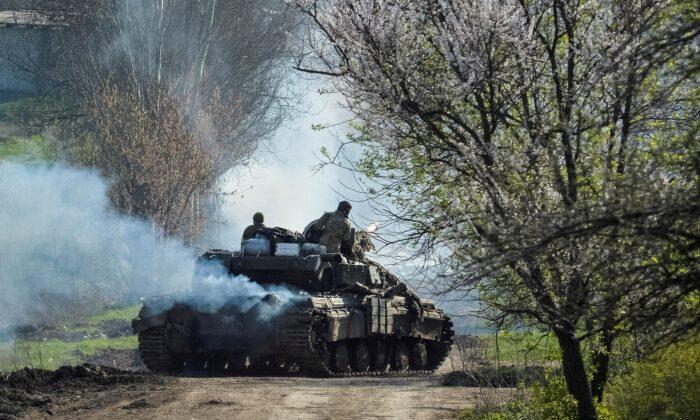Ukrainian forces are pulling back from parts of the flashpoint city of Bakhmut amid indications that Kyiv’s planned spring offensive may fail to materialize—at least in the short term.
Located in the eastern Donetsk region, Bakhmut has remained the scene of fierce ground fighting for the past several months.
According to an April 14 briefing from the British Defense Ministry, Russian forces in recent days have “re-energized” their assault on the city.
“The Ukrainian defense still holds the western districts of the town but has been subjected to particularly intense Russian artillery fire over the previous 48 hours,” the ministry stated.
It went on to assert that Ukrainian forces were currently conducting “orderly withdrawals from positions they have been forced to concede.”
Military experts say the fall of Bakhmut, a key Ukrainian transport hub, would likely pave the way for a Russian advance on contested positions to the north and northwest.
Russia invaded Ukraine early last year with the stated aim of protecting Russian speakers in the Donbas region—which includes Donetsk—and halting the eastward expansion of NATO.
Kyiv, along with most Western capitals, views the move as an unprovoked war of aggression.

Battles Still Being Waged
The British assessment of the situation in Bakhmut is roughly in line with recent statements from Russian military sources.On April 13, a Russian Defense Ministry spokesman said that Ukrainian forces were in the process of “retreating” from central Bakhmut. Meanwhile, the spokesman said, Russian airborne units were “blocking the redeployment of Ukrainian army reserves to the city.”
On the same day, however, Yevgeny Prigozhin, head of Russia’s Wagner Group, conceded that Russian forces hadn’t yet entirely encircled Bakhmut.
A private military company linked to the Kremlin, the Wagner Group is leading the fighting in and around the strategic city.
“Ukraine continues to bring up reserves and deploy them inside city limits,” the group quoted Prigozhin as saying on its official Telegram channel.
“Bloody battles are still being waged, so it’s too early to say that Bakhmut has been fully surrounded,” he said.
Prigozhin went on to assert that Russian forces now control more than 80 percent of the city but were still encountering “significant resistance.”
According to Ukrainian Deputy Defense Minister Hanna Maliar, large numbers of Russian troops are being redirected to Bakhmut from other areas along the 680-mile-long frontline.
“The enemy is using its most professional units [in Bakhmut] and resorting to a significant amount of artillery and aviation,” Maliar said via Telegram on April 14.

Spring Offensive in Doubt
Slow but steady Russian gains in Donetsk have been accompanied by mounting speculation that Kyiv was planning a major offensive aimed at retaking lost territory.There have been some indications that the planned counteroffensive will be aimed at relieving Bakhmut. Others suggest it would target the southern Zaporizhzhia region in hopes of shattering Russia’s land corridor to Crimea.
But the springtime offensive now appears increasingly unlikely, given the recent leak of classified U.S. military documents, most of which pertain to the situation in Ukraine.
One of the documents cited most often appears to suggest that the supply of munitions for Ukraine’s S-300 air-defense system stands on the verge of depletion.
On April 10, CNN, citing sources close to Ukrainian President Volodymyr Zelenskyy, said the intelligence leaks had prompted Kyiv to modify certain aspects of its planned counteroffensive.
On April 11, the Washington Post reported that one leaked U.S. military document—dating from early February—stated that Kyiv’s anticipated counteroffensive would likely achieve only “modest territorial gains.”
On the same day, Ukrainian Prime Minister Denys Shmyhal, during a high-profile visit to Washington, said the offensive could be postponed until later this summer.
“Our friends and partners comprehend clearly that in order to go into counteroffensive, one must be 100 percent ... prepared to do so,” Shmyhal said in an interview with U.S. newspaper The Hill.
In order to wage a successful counteroffensive, he said, the country needs more artillery and ammunition.

Kyiv: ‘Readying Our Boys’
Since then, however, officials in Kyiv have made statements suggesting that the planned spring offensive is still in the offing.“We’re readying our boys,” Zelenskyy declared in a televised address on April 13. “We look forward to the delivery of weapons promised by our partners.”
The following day, Oleksiy Danilov, head of Ukraine’s National Security Council, wrote on Twitter that Kyiv was ready to use all available nonproscribed weapons to “liberate” all Russia-held territories.
According to Danilov, this includes Crimea, which Moscow unilaterally annexed in 2014.





